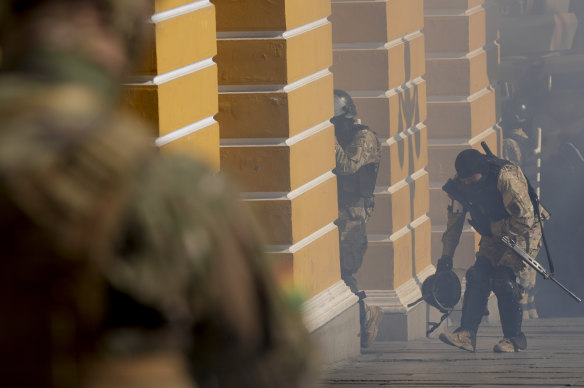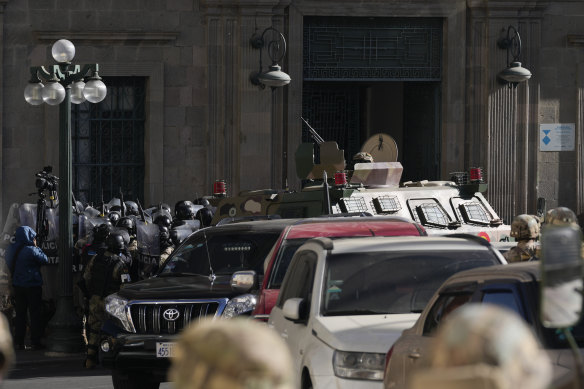
The rebellion followed months of tensions, with economic hardship and protests growing ever stronger as two political titans — Arce and his one-time ally, leftist former President Evo Morales — battled for control of the ruling party.

Soldiers walk amid tear gas they fired outside the Legislative Assembly in Plaza Murillo in La Paz, Bolivia.Credit: AP
Still, the apparent attempt to depose the sitting president appeared to lack any meaningful support, and even Arce’s rivals closed ranks to defend democracy and repudiate the uprising.
The spectacle shocked Bolivians, who are no strangers to political unrest; in 2019, Morales was ousted as president following an earlier political crisis.
As the crisis unfolded on Wednesday, military vehicles flooded into the plaza. Before entering the government palace, Zuniga told journalists: “Surely soon there will be a new cabinet of ministers; our country, our state cannot go on like this.” Zuniga said that “for now,” though, he recognised Arce as commander-in-chief.
Zuniga did not explicitly say he was leading a coup, but said the army was trying to “restore democracy and free our political prisoners”.

Military police gather outside the main entrance as an armoured vehicle rams into the door of the presidential palace in Plaza Murillo in La Paz, Bolivia.Credit: AP
Shortly after, Arce confronted Zuniga in the palace hallway, as shown in a video on Bolivian television. “I am your captain, and I order you to withdraw your soldiers, and I will not allow this insubordination,” Arce said.
Surrounded by ministers, he added: “Here we are, firm in Casa Grande, to confront any coup attempt. We need the Bolivian people to organise.”
Less than an hour later, Arce announced new heads of the army, navy and air force amid the roar of supporters, and thanked the country’s police and regional allies for standing by him. Arce said the troops who rose against him were “staining the uniform” of the military.
“I order all that are mobilised to return to their units,” said the newly named army chief Jose Wilson Sanchez. “No one wants the images we’re seeing in the streets.”
Shortly after, the armoured vehicles roared out of the plaza, tailed by hundreds of military fighters as police in riot gear set up blockades outside the government palace.
The incident was met with a wave of outrage by other regional leaders, including the Organisation of American States, Chilean President Gabriel Boric, the leader of Honduras, and former Bolivian leaders.
Bolivia, a country of 12 million people, has seen intensifying protests in recent months over the economy’s precipitous decline from one of the continent’s fastest-growing two decades ago to one of its most crisis-stricken.
There has also been a high-profile rift at the highest levels of the governing party. Arce and his one-time ally, Morales, have been battling for the future of Bolivia’s splintering Movement for Socialism, known by its Spanish acronym MAS, ahead of elections in 2025.
Following Wednesday’s chaos, reports on local media showed Bolivians stocking up on food and other essentials in supermarkets, concerned about what might come next.
But addressing supporters outside the presidential palace, the country’s vice president, David Choquehuanca, vowed: “Never again will the Bolivian people permit coup attempts.”
AP, Reuters
Get a note directly from our foreign correspondents on what’s making headlines around the world. Sign up for the weekly What in the World newsletter here.









 Add Category
Add Category